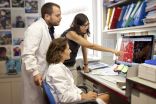(Press-News.org) Idiopathic pulmonary fibrosis (IPF) causes a gradual loss of respiratory capacity and can be lethal within a few years. The cause is unknown, although it can be attributed to a combination of genetics and the environment. A team of researchers from the Spanish National Cancer Research Centre (CNIO) have now discovered that telomeres, the structures that protect the chromosomes, are at the origin of pulmonary fibrosis. This is the first time that telomere damage has been identified as a cause of the disease. This finding opens up new avenues for the development of therapies to treat a disease for which there is currently no treatment.
This work, carried out by Juan M. Povedano and Paula Martínez from the Telomeres and Telomerase Group at CNIO led by Maria A. Blasco, with the participation of researchers from the CNIO Molecular Imaging Core Unit and from the Complutense University of Madrid, is being published this week in the journal Cell Reports.
Idiopathic pulmonary fibrosis is a respiratory disease ? affecting about 8,000 people in Spain ? in which scars are formed in lung tissue that make it rigid, leading to breathing difficulties. In the absence of a single and determinant cause, researchers compile clues that piece together different parts of the problem. One is that the exposure to environmental hazards, such as radiation, smoking or pollution, greatly increases the risk.
Other clues already pointed to the telomeres. For example, the telomeres of many patients suffering from idiopathic pulmonary fibrosis are shorter than normal. Furthermore, pulmonary fibrosis is one of the most frequent illnesses among people with mutations in genes involved in telomere maintenance. These data suggest that there is an association between telomere defects and the disease, but demonstration of causation was pending.
TELOMERE DEFECTS
In search of a cause-effect relationship, CNIO researchers created a mouse that lacked a protein needed to build telomeres in a specific cell population -- type II alveolar cells -- and which is indispensable for lung tissue regeneration.
The results left no room for doubt: most of the animals developed progressive pulmonary fibrosis. The researchers, after finding that the lack of telomeres is lethal for type II alveolar cells, reached the conclusion that lung epithelium cannot regenerate without these cells and, therefore, cannot repair damage caused by toxic environmental agents.
This result demonstrates, for the first time, that telomere damage may cause pulmonary fibrosis. In the words of Martínez: "We have seen that acute telomere damage is sufficient to trigger pulmonary fibrosis, even in the absence of environmental damage."
A MODEL THAT REPRODUCES THE DISEASE IN HUMANS
Although the mouse lacking telomeres in pulmonary epithelial cells proves the importance of telomeres in the origin of fibrosis, it does not however reproduce the disease in most human patients.
In humans, environmental hazards play an important role in the disease. Furthermore, short telomeres are also a feature of the disease. Very short telomeres are a permanent damage to cells and they stop dividing. When this happens, pulmonary tissue will cease to regenerate, and instead, a "protective" programme against damage will be triggered that causes scar formation -- which leads to fibrosis.
The researchers therefore developed an animal model that combines premature shortening of the telomeres due to telomerase deficiency, with low doses of environmental damage. To induce damage they chose bleomycin, a drug that affects the genetic material of cells and inhibits cell division when administered in high doses, but not enough to cause pulmonary fibrosis in normal mice at the low doses administered by the authors.
They saw that there is a synergy between the damage caused by bleomycin at low doses and the one caused by short telomeres. The shortening of the telomeres is not in itself sufficient to generate fibrosis, nor, in general, is bleomycin at low doses; however, both factors together do trigger the disorder.
"These findings support a model in which persistent damage derived from short or dysfunctional telomeres is added to other cellular damage and this triggers pulmonary fibrosis," says Povedano.
The new animal models are essential for testing new "therapeutic strategies based on the activation of telomerase [the enzyme that repairs telomeres]," concludes the paper in Cell Reports.
A LINK TO AGEING
This new evidence, which focuses on telomeres, fits in well with the fact that idiopathic pulmonary fibrosis only occurs in people over 50 years of age; it is precisely in the telomeres where one of the main molecular symptoms of cellular ageing occurs. Telomeres become shorter each time a cell divides; the older the organism, the greater the number of divisions and the shorter the telomeres.
Blasco asserts: "Understanding the molecular mechanisms that lead to the ageing process, such as the shortening of telomeres, has enabled us to generate animal models that faithfully reproduce diseases such as idiopathic pulmonary fibrosis, and this is already helping us to test novel therapies that we hope will prove effective and that are based on the activation of the enzyme telomerase."
INFORMATION:
The study has been funded by the Ministry of Economy and Competitiveness, the European Union, and the Fundación Marcelino Botín and Banco Santander through Santander Universities.
Reference article:
Mice with pulmonary fibrosis driven by telomere dysfunction. Juan M. Povedano, Paula Martinez, Juana M. Flores, Francisca Mulero, Maria A. Blasco. Cell Reports (2015). doi: 10.1016/j.celrep.2015.06.028.
A mutation found in most melanomas rewires cancer cells' metabolism, making them dependent on a ketogenesis enzyme, researchers at Winship Cancer Institute of Emory University have discovered.
The finding points to possible strategies for countering resistance to existing drugs that target the B-raf V600E mutation, or potential alternatives to those drugs. It may also explain why the V600E mutation in particular is so common in melanomas.
The results are scheduled for publication in Molecular Cell.
The growth-promoting V600E mutation in the gene B-raf is present in ...
The first comprehensive analysis of the woolly mammoth genome reveals extensive genetic changes that allowed mammoths to adapt to life in the arctic. Mammoth genes that differed from their counterparts in elephants played roles in skin and hair development, fat metabolism, insulin signaling and numerous other traits. Genes linked to physical traits such as skull shape, small ears and short tails were also identified. As a test of function, a mammoth gene involved in temperature sensation was resurrected in the laboratory and its protein product characterized.
The study, ...
MAYWOOD, Ill. - New devices called stent retrievers are enabling physicians to benefit selected patients who suffer strokes caused by blood clots. The devices effectively stop strokes in their tracks.
For the first time, new guidelines from the American Heart Association/American Stroke Association recommend the treatment for carefully selected patients who are undergoing acute ischemic strokes and who meet certain other conditions.
Loyola University Medical Center stroke specialist Jose Biller, MD, is a member of the expert panel that wrote the guidelines, published ...
Infrared date from NASA's Aqua satellite spotted the strongest storms within newborn Tropical Depression 10W over the Philippine Sea today, July 2. It is expected to strength to a tropical storm, at which time it will be renamed "Linfa."
A tropical cyclone is made up of hundreds of thunderstorms, and the highest storms are the coldest and most powerful. To identify those areas with the strongest storms, infrared data is used because it tells temperature. The higher the cloud top, the stronger the uplift in a storm and the colder the cloud top temperature will be.
The ...
By growing two types of stem cells in a "3-D culture" and measuring their ability to produce retinal cells, a team lead by St. Jude Children's Research Hospital researchers has found one cell type to be better at producing retinal cells.
The research not only reveals which stem cell type might be better for treating retinal degeneration, but it also demonstrates a standardized method for quantifying the effectiveness of different stem cells for such therapies.
The research was led by Michael Dyer, Ph.D., a member of the St. Jude Department of Developmental Neurobiology ...
Astronauts on the International Space Station (ISS) have a number of exercise options, including a mechanical bicycle bolted to the floor, a weightlifting machine strapped to the wall, and a strap-down treadmill. They spend a significant portion of each day working out to ward off the long-term effects of weightlessness, but many still suffer bone loss, muscle atrophy, and issues with balance and their cardiovascular systems.
To counteract such debilitating effects, research groups around the world are investigating artificial gravity -- the notion that astronauts, ...
The latest Supplement to the American Ornithologists' Union Check-list of North American Birds was published this week in The Auk: Ornithological Advances, and includes several major updates to the organization of the continent's bird species. More than just a list, the Check-list groups birds into genera, families, and orders based on their evolutionary relationships, and some of the most significant changes in this year's Supplement involve the tanagers, family Thraupidae. "Recent genetic studies have overturned much of what we thought we knew about what constitutes a ...
July 2, 2015 - While heart disease is the number one cause of death in both sexes, it poses special considerations in women--with risks often beginning in childhood and changing at different stages of life. Insights on cardiovascular disease (CVD) risk in women and girls throughout the life span are shared in a special symposium feature in the June issue of The American Journal of Medical Sciences (AJMS). The official journal of the Southern Society for Clinical Investigation (SSCI), AJMS is published by Wolters Kluwer.
Two symposium papers seek to increase understanding ...
ATLANTA - July 2, 2015-Cancer survivors who smoke report fewer negative opinions about smoking, have more barriers to quitting, and are around other smokers more often than survivors who had quit before or after their diagnosis, according to a new study appearing in Psycho-Oncology. The authors say these factors point to potential targets to help cancer survivors quit.
Quitting smoking is important for cancer prognosis, but some cancer survivors continue to smoke. Although initial quit rates are high among those diagnosed with cancers strongly linked with smoking (e.g., ...
A group of scientists led by Dr Kara Hoover of the University of Alaska Fairbanks and including Professor Matthew Cobb of The University of Manchester, has studied how our sense of smell has evolved, and has even reconstructed how a long-extinct human relative would have been able to smell.
The sense of smell plays a decisive role in human societies, as it is linked to our taste for food, as well as our identification of pleasant and unpleasant substances.
We have about 4 million smell cells in our noses, divided into about 400 different types. There is tremendous ...



